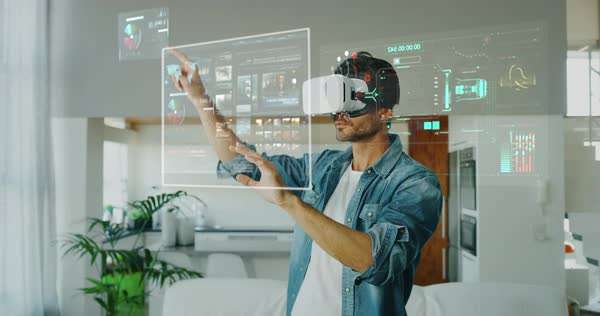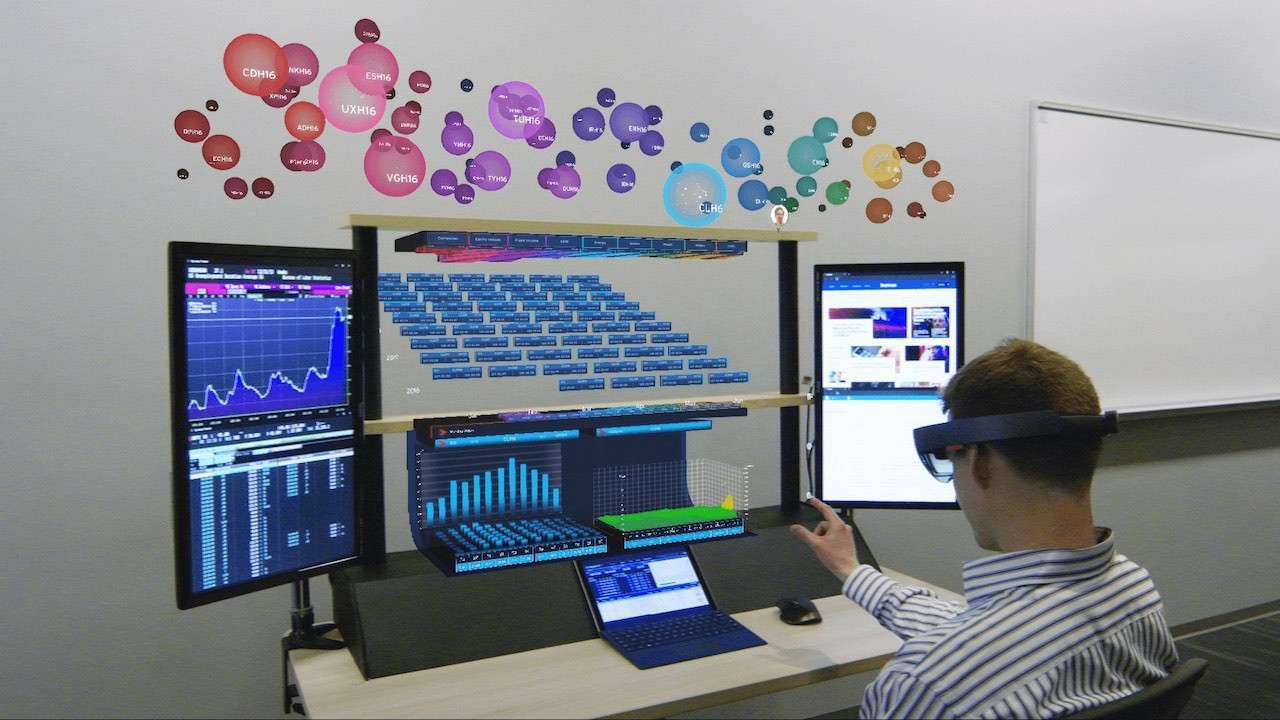Have you ever imagined being in outer space or any other planet or in the middle of your favorite video game world surrounded by your favourite characters ? We all had such dreams and imaginations when we were kids. Some of us (including me) still wish to live those dreams. Well, it’s not yet possible to physically be at such places for common people but, you can definitely ‘experience’ being there while you’re still at your home! Yes, you read that right! YOUR HOME! But how? Well, the answer is “Holographic Augmented Reality “! Holographic Augmented Reality, abbreviated as Holographic AR, is the future of Augmented Reality. While all Augmented Reality does, is enhance the real-world objects by computer generated information and displays the computerized and interactive environment through a display, headset, HUD or lens attached to the user, Holographic AR does the same but the user do not need to wear any kind of equipment. Instead, the entire surrounding of the user, is changed/enhanced using holograms.
Holographic AR
extracts people and objects from the real world, in real time, and immerse them into the virtual and enhanced environment where they can interact with digital elements naturally. In other words, it allows users to see themselves in the virtual world and interact with objects found within the same space. By overlaying the person’s image into the digital interface, it makes it appear as if the user is in a completely different world. An innovative aspect of Holographic AR uses body movement, like hand gestures, facial expressions, and voice commands, to act controllers of the experience.
If you’re a Marvel fan, then you must’ve heard about B.A.R.F (Binary Augmented Retro-Framing). This is the technology used by Mysterio to create the illusions in Spiderman: Far From Home. B.A.R.F is somewhat similar Holographic AR, as it also creates virtual objects around the user which are also interactive.
Holographic AR can also show live objects. People can talk face to face without being physically present.
Benefits of Holographic AR:
1) Childhood Development:
Children learn through experience and practice. In case of language or speaking development, early literacy depends widely upon high-quality experience that stimulate speaking and listening of the child. The most effective way to build up vocabulary and awareness of sentence structure is through real-world experiences.
2) Military:
Soldiers can be trained in the simulated virtual environments that are made according to the upcoming mission locations and make the soldiers aware of all the dangerous areas and the blind spots, along with virtual enemies for more intense training.
3) Gaming:
The greatest scope for Holographic AR in the near future. Holographic AR will definitely change how people play games now a days. Real life experience while playing virtual shooters and sports will make this one of the booming technologies in the future.
4) Enhanced Real-World Experience:
Children can learn new things from exploring the outside world like, the Stone Age, space, etc. created virtually by the Holographic AR.
5) Medical:
Surgeons and Doctors can operate on virtually simulated patient bodies and to learn more about the do’s and don’ts of surgery and achieve better results in the real life operations.

6) Education and Research:
Holographic AR can be used to closely study places where humans can’t be physically, like on top of an erupting volcano or inside a tornado.
Holographic AR surely has a bright future in the upcoming years with a lot of improvements and enhancements. Just imagine how cool it will be when you pick up a water bottle it feels like some sort of an Alien space gun! With this technology coming up, the future’s gonna be AWESOME!
Holographic Augmented Virtual Reality (HAVR) is a technology that combines elements of holography, augmented reality, and virtual reality to create a unique immersive experience.
HAVR involves projecting holographic images into the real world, which are then augmented with virtual elements to create a seamless blend of physical and virtual reality. This allows users to interact with virtual objects in a more natural way, as they can see and manipulate them in a physical space.
The technology behind HAVR involves using specialized cameras and projectors to capture and display holographic images, as well as advanced tracking systems to detect and respond to user movements. HAVR also typically requires a high level of computing power to generate and render the virtual elements in real-time.
HAVR has potential applications in a wide range of fields, from entertainment and gaming to education, training, and healthcare. For example, HAVR could be used to create more immersive training simulations for healthcare professionals, or to provide new forms of interactive entertainment for consumers.
One of the key features of HAVR is its ability to project holographic images into the real world. This is achieved through the use of specialized cameras and projectors, which capture and display the holographic images. These images are then augmented with virtual elements, creating a seamless blend of the physical and virtual worlds.
The use of advanced tracking systems is also an important part of HAVR technology. These systems track the user’s movements in real-time, allowing them to interact with the virtual objects in a natural and intuitive way. This creates a more immersive and engaging experience for the user.
The computing power required for HAVR is also quite high. In order to generate and render the virtual elements in real-time, powerful computing systems are needed. This includes high-performance CPUs and GPUs, as well as specialized software and hardware specifically designed for HAVR.
While HAVR is still a relatively new technology, it has already shown great potential in a number of different fields. For example, in the entertainment industry, HAVR could be used to create more immersive and engaging gaming experiences. This could include games that allow users to physically interact with virtual objects in a more natural way, such as picking up and manipulating objects with their hands.
In the field of education, HAVR could be used to create more engaging and interactive learning experiences. For example, students could use HAVR technology to explore historical sites and events in a more immersive way, or to interact with virtual simulations of scientific concepts and experiments.
HAVR also has potential applications in healthcare and medical training. For example, medical students could use HAVR technology to simulate surgical procedures in a more realistic and immersive way, allowing them to practice and refine their skills in a safe and controlled environment.
Overall, HAVR is an exciting technology with a wide range of potential applications. As the technology continues to evolve and improve, it is likely that we will see even more innovative and exciting uses for HAVR in the future.
HAVR has the potential to revolutionize the way we interact with technology and the world around us. One of the key benefits of HAVR is its ability to create more natural and intuitive user experiences. With HAVR, users can interact with virtual objects in a more natural way, using their hands and body movements to manipulate and control virtual elements.
read more: How social media functions in the growth of business in 2023
In addition to creating more natural user experiences, HAVR also has the potential to increase productivity and efficiency in a variety of different industries. For example, HAVR could be used in manufacturing to help workers visualize and interact with virtual prototypes of products before they are built. This could help to identify design flaws and improve the overall production process.
Another potential application for HAVR is in the field of architecture and construction. With HAVR technology, architects and engineers could create virtual models of buildings and structures, allowing them to visualize and test designs before construction begins. This could help to reduce errors and save time and money in the construction process.
HAVR could also have applications in the field of transportation, particularly in the development of autonomous vehicles. By using HAVR technology to simulate real-world driving scenarios, developers could more accurately test and refine autonomous vehicle technology, ensuring that it is safe and effective before it is deployed on public roads.
The potential applications of HAVR are virtually limitless, and as the technology continues to evolve, we are likely to see even more innovative and exciting uses for this technology. Whether it’s in entertainment, education, healthcare, or industry, HAVR has the potential to create more immersive, engaging, and effective user experiences across a wide range of different fields.
One of the challenges facing HAVR technology is the need for high-quality content. In order for HAVR to be truly effective, it needs to offer engaging and immersive experiences that can hold users’ attention over an extended period of time. This requires high-quality content that is both visually stunning and interactive.
To address this challenge, many companies are investing in the development of new HAVR content. This includes everything from games and entertainment experiences to educational and training simulations. Some companies are even creating entire HAVR platforms that offer a wide range of different experiences, catering to a variety of different interests and needs.
Another challenge facing HAVR technology is the cost of hardware and software. Because HAVR requires specialized hardware and software, it can be quite expensive to develop and deploy. This has limited the adoption of HAVR technology in some industries, particularly in smaller organizations or those with limited budgets.
However, as HAVR technology continues to evolve and become more widespread, it is likely that the costs associated with this technology will decrease. This could help to make HAVR more accessible to a wider range of organizations and users, opening up new opportunities for innovation and growth.
Overall, HAVR is a powerful technology with the potential to transform a wide range of industries and experiences. While there are challenges associated with the development and adoption of HAVR technology, there are also exciting opportunities to create new and innovative experiences that can engage and inspire users in ways that were previously impossible.


